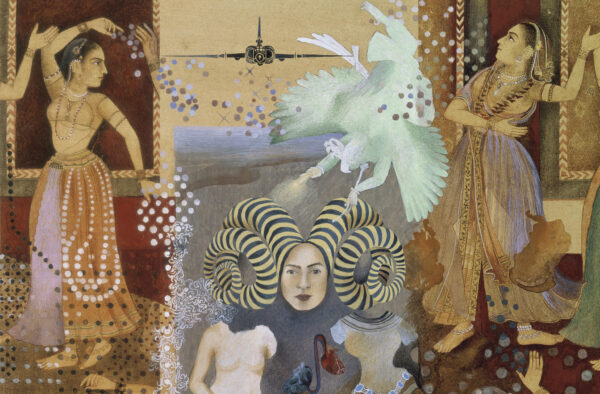
Shahzia Sikander, “Pleasure Pillars” (detail of upper half), 2001, vegetable color, dry pigment, and watercolor on tea-stained wasli paper, 43.2 x 30.5 cm., collection of Amita and Purnendu Chatterjee. Photo: MFAH.
Extraordinary Realities, an exquisite 15-year survey devoted to the painter and multimedia artist Shahzia Sikander (b. 1969), which was at the Museum of Fine Arts, Houston (MFAH) through June 5, featured work made in four cities that possesses multiple stylistic and iconographic references designed to subvert and explode conventional categories.
Sikander, who considers herself a “citizen of the world,” was born in Lahore, Pakistan, where, as an undergraduate, she studied and emulated courtly Indian and Persian paintings made for lavish books commissioned by royal patrons. The three Indo-Persian traditions most relevant to her art are: Mughal (1526-1867), an era when Islamic rulers of Persian origin ruled significant parts of India; painting from independent Hindu states from the sixteenth and seventeenth centuries through 1825, which is generally referred to as Rajput painting; and the Safavid dynasty (1501-1722), which produced the greatest art made during Iran’s Islamic period. Sikander had little exposure to Hindu art (even in reproduction) until she came to the U.S. See: Debra Singer, “Shahzia Sikander: Acts of Balance,” 2000.
The historic paintings from these traditions are commonly referred to as “miniatures,” a term falling out of favor due to its association with the colonialist dispersal of such works (though no new term has taken its place). After receiving her B.F.A. from the National College of Arts, Lahore, in Miniature Painting in 1991, Sikander attended the Rhode Island School of Design (RISD), where she received her M.F.A. in Painting and Printmaking in 1995. From 1995 to 1997, she was a Core Program resident at the MFAH Glassell School of Art. Sikander subsequently moved to New York, where she has executed increasingly complex paintings, such as Pleasure Pillars. For an overview of Sikander’s work in these four cities, as well as her productive engagement with women artists, artists of color, and theory, see Pepe Karmel’s excellent discussion in The Brooklyn Rail.
Pleasure Pillars, 2001
In the detail illustrated above, two elaborately garbed and bejeweled dancing girls (which closely follow such figures in traditional Indian paintings) form the uppermost pair of pillars. Below them are two decapitated ancient statues: the one on the left is a classical Venus (similar to the Venus de Milo), while the one on the right is a goddess from Southeast Asia. Joined by a pair of arteries, a black heart and a red heart float between these two statues (I thought it might have been inspired by Frida Kahlo’s The Two Fridas, but Sikander informed me it was not). Sikander has depicted her own disembodied head between the two headless statues, proffering herself as a mediator between these two vandalized goddesses, as well as a recuperator of the violent destructions directed against women and losses suffered by them.
Sikander has outfitted her head with an enormous pair of ram’s horns, a longstanding symbol of might, painted in dramatic black and yellow stripes. Just above her own head, Sikander depicts a green, parrot-like bird with faded colors whose swooping form recalls the emblematic American eagle. It possesses human arms, which proffer a sparkler in one hand, and a long-stemmed flower in the other.
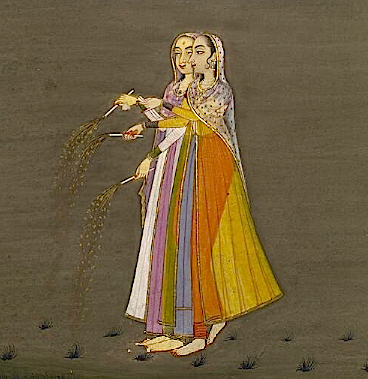
Unknown Indian artist (Bikaner school), “Two Nautch Girls with Sparklers by a Stream on the Night of the Diwali Festival” (detail), c. 1790-1800, album leaf; gouache with silver and gold on paper, sheet: 6 3/4 × 4 1/8 inches, collection of MFAH. Photo: MFAH.
This painting of girls with sparklers was one of the works exhibited at the entrance to the Sikander exhibition. It confirms that the object held by the bird is a sparkler.
As for the identification of the bird, Sikander explained to me that it is Garuda (often represented as an eagle with anthropomorphic features, sometimes green in color), who is the mount and symbol of the Hindu god Vishnu. Sikander characterizes Garuda this way:
a mythical steed, a salient theme in Hindu Mythology, with multiple symbolisms around flight, imagination, immortality, birth, heaven, swiftness, protector, shapeshifter, and so forth.
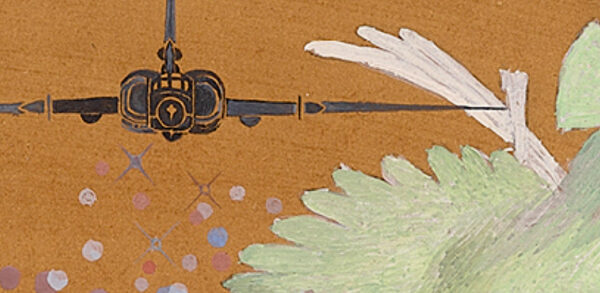
Shahzia Sikander, “Pleasure Pillars” (partial details of jet and Garuda), 2001, vegetable color, dry pigment, and watercolor on tea-stained wasli paper, 43.2 x 30.5 cm., collection of Amita and Purnendu Chatterjee. Photo: detail of exhibition catalogue cover.
A sinister jet fighter (added to this painting after the 9/11 attacks on the World Trade Center and the Pentagon) appears above Garuda — but in a disorienting contradiction in scale, its left wing appears to be in front of the bird’s tail feathers. The four x’s suggest targets acquired by the jet’s radar. After 9/11, various Islamaphobic initiatives targeted Muslims. It began in an official capacity with George W. Bush’s disastrous “War on Terror” (which he initially termed a “crusade” and subsequently augmented with the secret “rendition” of muslims to overseas torture facilities). Donald J. Trump’s initial “Muslim Ban” was essentially a celebration of indiscriminate Islamaphobia. The highlighted nose of the jet at the top of Pleasure Pillars fortuitously resembles a Christian cross (Sikander noted to me in an email that this shape was not intentional).
The floating dots distributed throughout the painting are disorienting: they possess no clear and uniquely stable significance. In an essay in the excellent exhibition catalog Shahzia Sikander Extraordinary Realities (produced by the RISD Museum and Hirmer), Sadia Abbas notes that the dots, which constitute an important motif in Sikander’s paintings, first appeared in the painting Perilous Order (1989-1997), where they are overlaid on a painted marbleized pattern. Abbas adds that Sikander emphasizes the labor required to make her dots, in contrast to some modernist Western artists, who make great sums of money from simple paintings of dots (often produced in factory-like conditions by assistants, one might add). Abbas also points out that in some of Sikander’s paintings, the dots are deployed to suggest bullet holes, while in others, they function as globes (as in United World Corp, 2003). They can also resemble planets, and evoke many other associations.
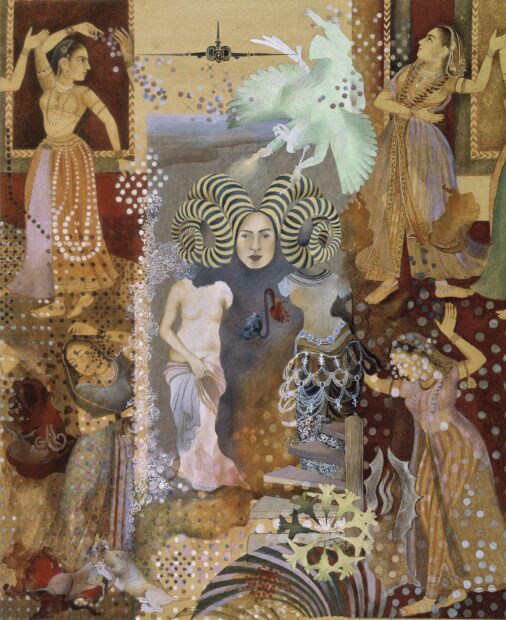
Shahzia Sikander, “Pleasure Pillars” (full painting), 2001, vegetable color, dry pigment, and watercolor on tea-stained wasli paper, 43.2 x 30.5 cm., collection of Amita and Purnendu Chatterjee. Photo: MFAH.
In Pleasure Pillars, the dots vary greatly in size and clarity. In several places, dots are overlaid on other dots, which provides a vertiginous sense of depth. In the upper left, the dancing woman almost seems to toss dots from her right hand to the outstretched hand of another dancer. (This hand is all that remains of this figure, because the frieze of dancers has been ruptured by the landscape with the black jet and green bird.) At the same time, the cluster of white dots below the woman’s left hand rhymes with the oversized pearls that hang from her waist. The dots can seem random, or they can form patterns or fields, like reflections from a cosmic disco ball or patterns on fabric. They in fact seem to blend into the fabrics worn by the pair of dancing women at the bottom of the painting. In Pleasure Pillars, Sikander’s dots continuously oscillate between blockage, synthesis, and rupture.
The manner in which Sikander renders dots — and this is true of virtually all of the forms in her paintings — differs from how people and objects are treated in traditional Indo-Persian paintings. The latter have crisply delineated contours and preternatural clarity and sharpness. Sikander, by comparison, varies her treatments of forms. She tends to blur edges and distinctions, reinforcing the bleeding and blending caused by the tea stains and the accidental effects of watercolor that undergird her compositions. Sikander’s elisions enable worlds to dissolve and collide.
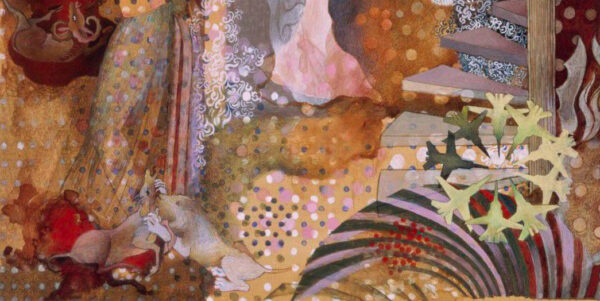
Shahzia Sikander, “Pleasure Pillars” (detail of lower left), 2001, vegetable color, dry pigment, and watercolor on tea-stained wasli paper, 43.2 x 30.5 cm., collection of Amita and Purnendu Chatterjee. Photo: MFAH.
The black jet at the top of the painting is rendered with chilling clarity and precision. In contrast, in the lower right, a ring of green forms is rendered in a more ghostly fashion. At first glance, they appear to be hummingbirds, perhaps grouped around a feeder. The green form at top center most distinctly resembles a hummingbird (its beak superimposed directly over a dot). But, as one proceeds clockwise, the hummingbirds evolve into fighter jets (the final two of which are dark). These hummingbirds and jets are superimposed over a staircase taken from Sikander’s breakthrough painting (discussed at length below). This staircase appears in several of Sikander’s works, and she informs me that it puts into play several ideas, including notions of ascent and descent, a cyclical loop, and the function of a bridge between spaces or conceptions. Thus a circle of natural wonders (hummingbirds) and technological agents of almost unimaginable destruction (jet fighters) is superimposed over a domestic, circular staircase ripe with symbolic possibilities.
In the lower left of the above detail, a maned lion (thus a male one) has an antelope by the throat, enacting a symbolic patriarchal decapitation (though female lions do most of the hunting and other work, while males mostly patrol their territory, like jet pilots cruising a national border).
Gayatri Gopinath, in her very insightful catalogue essay “Promiscuous Intimaces: Embodiment, Desire, and Diasporic Dislocation in he Art of Shahzia Sikander,” notes that one justification of the 2001 U.S. invasion of Afghanistan was to “save Muslim women from Islamic extremism.” One should note that it was U.S. aid — utilized as part of a proxy war against the Soviet Union — that enabled Islamic forces to regain power in Afghanistan. Nor was there ever any discussion from U.S. state sources of “saving women” from extremist prohibitions and penalties in Saudi Arabia, which has exported these practices to other countries.
Gopinath views Pleasure Pillars as a riposte against:
such paternalistic and fetishizing gendered discourses and insists on reviving submerged and forgotten narratives, genealogies, and traditions of pleasurable, sensuous, and joyous gendered embodiments.
Gopinath concludes that Sikander’s disruptions of time, space, and culture have significant implications:
Pleasure Pillars, and indeed all of Sikander’s paintings, suggest an alternative architecture of gender — one that resists the grid and straight lines of gender and sexual normativity and instead spirals, loops, and scatters across multiple temporal and geographic terrains.
From the Beginning
At the entrance to the exhibition, a section called “Shahzia Sikander Selects” featured Indian and Persian paintings from the MFAH’s permanent collection (including the sparkler painting reproduced above). They provided a sampling of the Indo-Persian traditions that served as artistic points of departure.
Mirrat I was made while Sikander was still a student at Lahore. Its political message cannot be grasped without knowledge of Pakistan’s history. The painting depicts a portion of the famous Lahore Fort, whose gates, fortifications, palaces, and gardens were built by several of the greatest Mughal emperors, including Akbar, Jehangir, Shah Jahan and Aurangzeb. Sikander depicts her friend Mirrat three times, garbed in a red sari. Though the sari had been a traditional form of dress in India for thousands of years (Pakistan and India were not partitioned until 1947), it was deemed “un-Islamic” by a 1970 decree promulgated by the Pakistani dictator Mohammed Zia-ul-Haq, who died the year before Sikander began this painting. Thus Sikander pictures Mirrat in the traditional garb worn during the reigns of many of India’s most important Muslim rulers (and for centuries thereafter), situated in the fortress that they built. It serves as a critique of the laws regulating women that were imposed by the dictator Zia under the influence of his Saudi patrons.

Shahzia Sikander, “The Scroll,” 1989–90, watercolor and gouache on tea-stained wasli paper, 34.3 x 162.2 cm., collection of the artist. Photo: MFAH.
The Scroll served as Sikander’s B.F.A. thesis project. Clad in white, Sikander depicts herself more than thirty times in an imaginary expansive space inspired by her parents’ home. These self-depictions range from fully solid to ghostly transparency as she meanders through the house.
On the far left, she is stepping out of the decorative frieze border (where she is semi-transparent) into the painting proper. Just above this initial image, she attains solidity as she climbs the stairs and enters the house.
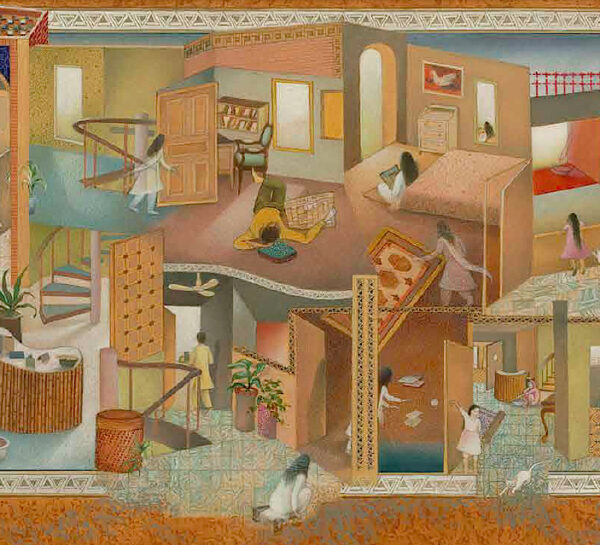
Shahzia Sikander, “The Scroll” (detail of center), 1989–90, watercolor and gouache on tea-stained wasli paper, 34.3 x 162.2 cm., collection of the artist. Photo: exhibition catalog.
In several instances the house and its grounds break through the frieze at the bottom of the painting. This breaking-the-bounds-of-the-frame happens twice in the detail illustrated above. These disruptions of the framing device serve as additional violations of the conventions of miniature painting (I use the term here to refer to not only the original Indo-Persian works, but the contemporary paintings that continue that tradition).
In the lower left of the same detail, one can see the bottom of the spiral staircase that was featured in Pleasure Pillars. In the foreground, another pillar and railing points to a mysterious lower level. It seems to be in the process of being evacuated in the artist’s imagination, just as the flooring breaches the frieze frame and seeps into the marble-patterned paper. We seem to be witnessing Sikander’s process of artistic “construction,” which cannot be contained within the conventional frame of illusion.

Shahzia Sikander, “The Scroll” (detail of lower right corner), 1989–90, watercolor and gouache on tea-stained wasli paper, 34.3 x 162.2 cm., collection of the artist. Photo: exhibition catalog.
On the far right, Sikander stands with her feet and legs (which are semi-transparent) outside of the painting proper. Brush in hand, she depicts herself — not in miniature, but in a full-sized easel painting.
Sikander notes in the catalog that when she painted The Scroll, she wanted to make something more ambitious than the typical “miniature template” of figures in a landscape. Typically, a B.F.A. thesis project under her advisor, Bashir Ahmed, entailed the execution of three or four miniatures on a given theme.
At the same time that Sikander breaks with the miniature format itself, she also departs from the hyper-real, detailed manner that typifies Indo-Persian painting, which she calls “painting insane amounts of detail.” (Otherwise, it would have taken her more than a year and a half to make The Scroll.) The patterns Sikander deployed in The Scroll relate to traditional patterns, but she devised them herself. She wanted to be connected to tradition, but to be recognizably original and contemporary as well.
In preparation for this work, Sikander immersed herself in various artistic traditions (including Chinese scroll painting, the films of Satyajit Ray, Mughal architecture as well as vernacular architecture in present-day Pakistan, and David Hockney). She also delved into music and poetry. Sikander describes these influences as emotional as well as intellectual. Indo-Persian paintings typically functioned as discrete images. These could be portraits, historical scenes, or an individual illustration of a particular episode within an epic literary narrative. Sikander made The Scroll into something more comparable to an epic narrative, rather than a single scene from one. A useful analogy is the relation of a film still to a film. In The Scroll, she has given us a complete vision of a world, a full narrative rather than one discrete piece of a narrative.
The scale of the house depicted in The Scroll is so amazing that I kept thinking of the Biblical phrase “In my Father’s house there are many mansions” (John 14:1-6). The literature around the show emphasizes that the house in The Scroll was inspired by her parents’ house, so I asked Sikander to clarify the relationship between her parent’s home and the painted palace.
Her reply, by email, demonstrated that the relationship was much more tentative than I had thought:
The “house” takes creative license, it is inspired by, but not literally my parents home. No parts are copied from any sources. It is all created from my sketches and studies of rooms, spaces, environments, imagined and real, around me, studies which I did first in large scale collages. The “architecture” in The Scroll is also a study of the local (Lahore) contemporary architecture vernacular (for example I was looking at the architect Nayyar Ali Dada’s work, one of the prominent architects of Pakistan as inspiration) as well as the depiction of interior space in historical Safavid painting. The house is intended to be a moment in time, a labyrinth of sorts, a portal into space, one door leading into the next — it is intentionally about space, which is infinite.
She added that her parents’ actual house is “very small.”
Sikander explains in the catalog that the painting “is about the confines of a space and a woman’s relationship to it.” The restrictions placed on women in Pakistan (mentioned above) took place when Sikander was ten. As she notes in the catalog, these restrictions deeply impacted the painting:
I focused on the house as a muse in those days, with the looming Hudood Ordinances. As a young single woman, one could not freely roam around in public spaces, so it made sense to me to locate the work inside the parents’ home, where I was going to spend the majority of my time. The woman in The Scroll is present everywhere all at once. An active agency, not the passive woman often depicted in historical Indian paintings like those of the Kangra school — restrained, awaiting.
In a statement about this painting on the Morgan Library’s website (which features a zoomable image of The Scroll as well as an untranscribed recording), Sikander describes herself as “a floating ghostlike presence in every chapter or segment” of the house.
She adds:
My diaphanous moving and morphing form is rendered in white gouache, and one can never see my face. I was making a statement on the restlessness of youth and the quest for identity. The claiming of the freedom for the female body in the domestic setting.
But while Sikander could roam her parent’s home at will, she —like other women in Pakistan after 1979 — were prohibited from walking in public without a chaperone. In The Scroll, she enjoys the domestic freedom of movement that she is denied in public.

Sikander receiving an award from Prime Minister Nawaz Sharif at the first NCA convocation. Frontier Post, Lahore, January 22, 1993.
As Sikander notes in the catalog: “The Scroll created a huge national rupture in the debate on who and what could be a contemporary miniature.” She also mentions her photo-op with the prime minister.
Sikander told the Brooklyn Rail in 2016 that miniature painting was an “anomaly” in the NCA’s westernized curriculum. It was also a relatively new major, rather than an established one. As she noted in a 2014 op ed in the New York Times, contemporary miniature painting was derided as craft (rather than art) and “regarded as tourist kitsch.” She, however, recognized its potential as a tool that could be turned on itself, to deconstruct its own stereotypes. She adds:
What others saw as enslavement to tradition, I recognized as a path to expanding the medium from within, embracing the complexities of craft and rigor in order to open up possibilities for dialogue.
Sikander single-handedly revivified the miniature by demonstrating how painting could be fresh and contemporary at the same time that it referred to (and in fact depended upon) archaic traditions. Sikander’s accomplishment was considered so important that she was offered a teaching position at her alma mater.
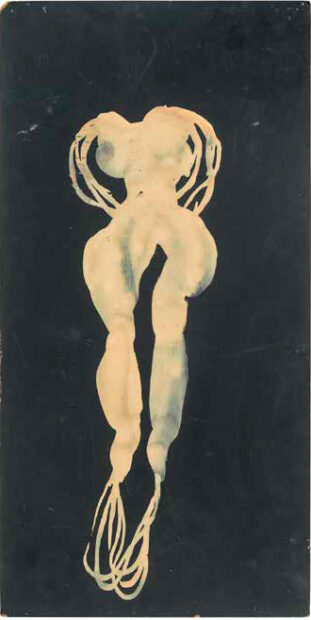
Shahzia Sikander, “A Slight and Pleasing Dislocation,” 1993, gouache and gesso on board, 67.5 x 37 cm., collection of
Cincinnati Art Museum. Photo: exhibition catalog. (This version was not in exhibition.)
Sikander did a great deal of drawing at RISD, where she learned to work in a looser, speedier manner. A Slight and Pleasing Dislocation, a crucially important work Sikander painted at RISD, is called Sikander’s “avatar” in a catalog essay by Kishwar Rezvi. This description is fitting, since the form recurs in many of the artist’s subsequent works (other headless female forms also abound, including the decapitated goddesses in Pleasure Pillars).
The body’s form is that of a female fertility figure, like those found at the entrances to Hindu, Buddhist, and Jain temples. Such figures all feature abundant breasts and hips. But instead of arms, Sikander’s figure has tendrils, and instead of feet, it has tendrils or roots that connect with one another, as if this figure was uprooted as well as bound.
As Sikander told Sara Christoph in a 2016 Brooklyn Rail interview:
A very signature image for me is the feminine form that has roots — rather than feet — but does not have a head. So much of the shared history between India and Pakistan dates back centuries, and the idea of the female divinity was very present within a complex system. That’s been expunged from so many cultures and religions, specifically Islam, and the headless form — for me, a beheading — emphasizes the removal of the feminine.
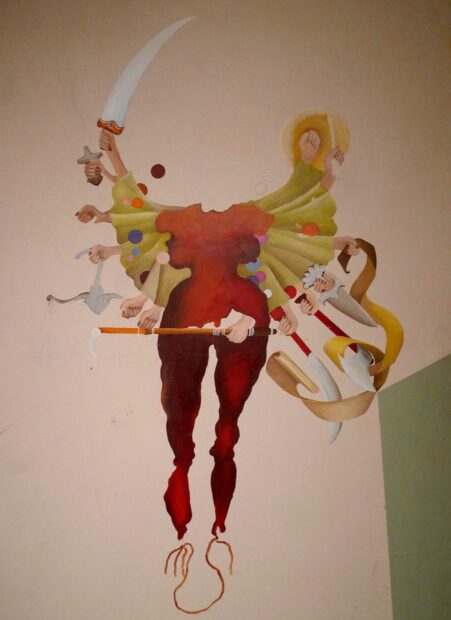
Shahzia Sikander, “A Slight and Pleasing Dislocation II” (detail of figure), 2001, acrylic on board, 238.2 x 128.4 cm., collection of the artist. Photo: Ruben C. Cordova.
The core of this figure’s monumental body follows the model of the first version. But instead of tendrils, this figure seems to appropriate the multiple arms cloaked in green sleeves that fan out behind her torso. Thirteen female hands are depicted, and it looks like Sikander intended about six more to be included in the composition. Nearly all wield formidable weapons, mostly axes and swords, though one holds a green ribbon and another a balance. Sikander has transformed her avatar into the goddess Durga, who is most famous as the slayer of the Buffalo Demon Mahishasura. Durga is the only entity that can kill the demon. In order to accomplish this feat, she utilizes copies of the weapons of the other gods, which is why she needs so many arms.
Sikander had been commissioned to paint a 50-foot mural for a New York law firm. This uncompleted panel (portions of it are sketched in, including several dots) was part of that monumental program. After the 9/11 attacks, the law firm was uncomfortable with the militant imagery, and asked Sikander to change her painting, which caused her to withdraw from the commission altogether. This explains the painting’s unfinished state.

Shahzia Sikander, “Venus’s Wonderland,” 1995–97, vegetable color, dry pigment, watercolor, traces of graphite, and tea on wasli paper, 31.6 x 27.7 cm. Rachel and Jean-Pierre Lehmann Collection. Photo: MFAH.
Venus Wonderland is based on an ancient Hindu fable (originally written in Sanskrit) collected in the Panchatantra, wherein a monkey outwits a crocodile whose wife wants to devour its heart. In the Buddhist version, Buddha was that monkey in a former life. The tales were widely disseminated and translated in Asia and the mid-East (before they reached the rest of the world), including the Persian Kalila wa-Dimna.
In the early versions, the monkey inhabited a blackberry or a fig tree. But Sikander places hers in an apple tree, invoking the Garden of Eden myth. Here the monkey, which is comically veiled and haloed, drops apples (another cognate to Sikander’s dots) picked from the tree from which s/he hangs. Unlike the unknowing Biblical Eve, Sikander’s Eve — the recipient of the monkey’s apples — is the Roman goddess of love and the mother of Cupid. Her features and pose are taken from Botticelli’s famous painting The Birth of Venus.
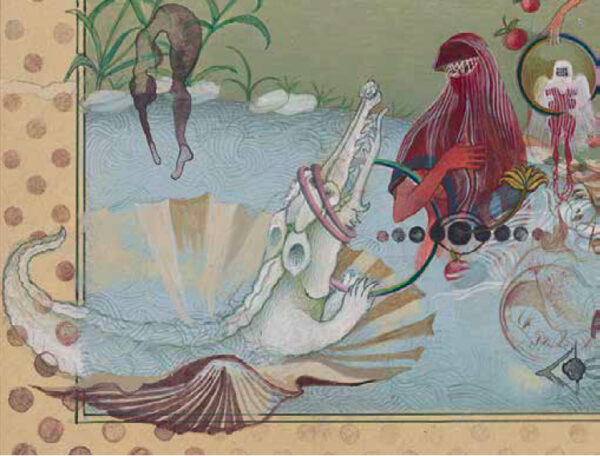
Shahzia Sikander, “Venus’s Wonderland” (detail of lower left), 1995–97, vegetable color, dry pigment, watercolor, traces of graphite, and tea on wasli paper, 31.6 x 27.7 cm. Rachel and Jean-Pierre Lehmann Collection. Photo: exhibition catalog.
Evidently unaware of the falling apples, Sikander’s veiled and gowned Venus/Eve looks at the crocodile, who frolics in the large half-shell that brought the newly birthed goddess to the shore. The monkey and crocodile appear to be playing a game. Two rings have passed through the croc’s snout and are around its head. The monkey holds a third ring with its left paw, ready to make another throw. Venus/Eve holds a much larger ring in the crook of her arm, which the crocodile fingers.

Shahzia Sikander, “Venus’s Wonderland” (large detail) 1995–97, vegetable color, dry pigment, watercolor, traces of graphite, and tea on wasli paper, 31.6 x 27.7 cm. Rachel and Jean-Pierre Lehmann Collection. Photo: exhibition catalog.
There is much going on in this painting. A veiled “avatar” figure based on the one in A Slight and Pleasing Dislocation is behind the ring held by the monkey (her garments seem to pass partially through the ring). A small (or distant) dark woman, wearing only a long veil, kicks her right leg forward and extends her right arm backward. Another female figure — as abstract as a Matisse cut-out — is folded over some vegetation on the left. A small red female figure in the right foreground appears to be wearing only a veil.
Perhaps the strangest creature in this menagerie is the veiled — and seemingly blindfolded — griffon. Sikander identifies with the griffon, which she traces back to Alexander the Great’s conquests. She in turn relates the griffon to the chalawa, a small farm animal endangered by urbanization. Sikander explains her preference for multiple identities on the Morgan Library website:
The chalawa is a ghost. In my usage, it’s somebody who is so swift and transient, you can’t pin down who they are. I am identifying with the chalawa, resisting the routinely confronted categories: “Are you Muslim, Pakistani, artist, painter, Asian, Asian American, or what?”
Sikander mocks the veil — what’s the point of a veil on an otherwise naked monkey? It’s as senseless as forcing women to wear veils, head coverings, etc. At the same time, Sikander celebrates difference, hybridity, and resistance to being defined by a simple category that is imposed by someone else.
In her catalogue essay, Gopinath views Venus’s Wonderland as “the wonderland of queer utopian possibility,” a vision of “a world untethered from the rules that govern a binary sex-gender system, and that separate the human from the nonhuman.”
She notes the work’s “disorienting collision of multiple art-historical traditions and cultural vocabularies.” Feminine images from multiple cultures are “fragmented, layered, submerged, obscured, and entangled with one another and with earth, sky, water, and nonhuman entities.”
Gopinath divines a deep meaning in these entanglements:
Gender as a stable category of identity is exploded; the work instead evinces a radical interspecies relationality, an interdependence of human and nonhuman, animate and inanimate worlds. The veil, that overdetermined and fetishized marker of Muslim femininity, is here shredded into tendrils and rendered in white paint so that it both obscures and reveals simultaneously; it covers both human and nonhuman figures so as to render its meaning as a gendered signifier absurd and nonsensical. Sikander thus refuses transparency and the “will to see” in favor of an open-ended, shifting array of meanings and allusions that never congeal into static gender formations.

Shahzia Sikander, “Riding the Ridden,” 2000, vegetable color, dry pigment, watercolor, and tea on wasli paper; 20.3 × 13.7 cm. Collection of Niva Grill Angel. Photo: Morgan Library website.
Riding the Ridden features two figures in silhouette, both of whom wear garments belted at the waist. The figure on the right is female, and the figure on the left is male. Their upper bodies are doubled, implying motion and thus sexual intercourse (which is, at the very least, imminent). The female head in the foreground wears a cowboy hat. (“Ride-‘em, cowgirl,” one might say in Texas vernacular.) Another cowboy hat is sketched in the lower right corner of the piece.
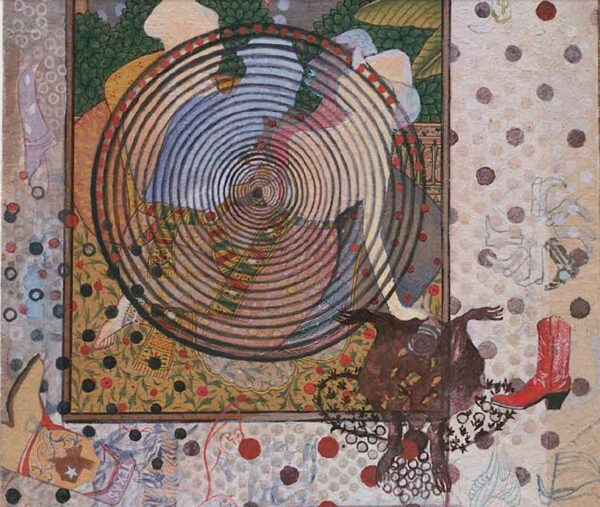
Shahzia Sikander, “Riding the Ridden” (detail), 2000, vegetable color, dry pigment, watercolor, and tea on wasli paper; 20.3 × 13.7 cm. Collection of Niva Grill Angel. Photo: Morgan Library website.
With limited access to television programming, Sikander had watched many Western movies as a child, and she was fascinated by regional iconographies. Influenced by her time in Houston, Sikander has synthesized a Kangra-style painting from Northern India (with all the usual flora evident in this school of painting) with cowboy iconography. These include numerous depictions of cowboy boots, including one inscribed with the word “Texas” in the lower left, and one inscribed with “New York” in the upper left. There is even a sketched wheel of cowboy boots (reminiscent of the wheel of hummingbirds/jet fighters in Pleasure Pillars) to the right of the woman. This wheel of cowboy boots materializes in painted form in Elusive Realities (1989-2000), a painting to which Sikander returned after many years.
The concentric circles that are superimposed over the two figures carry numerous potential meanings. These include: target, mandala, the Islamic nine heavens, the circle as a modernist motif, the self, timelessness, evolution, bullet holes, etc.
Riding the Ridden is a punning title, similar to Riding the Written and Writing the Ridden. Sikander explained to me that these titles all use wordplay to examine what constitutes “tradition” or “history,” and thus “who gets to define what is already ‘written’ or ‘ridden.’”
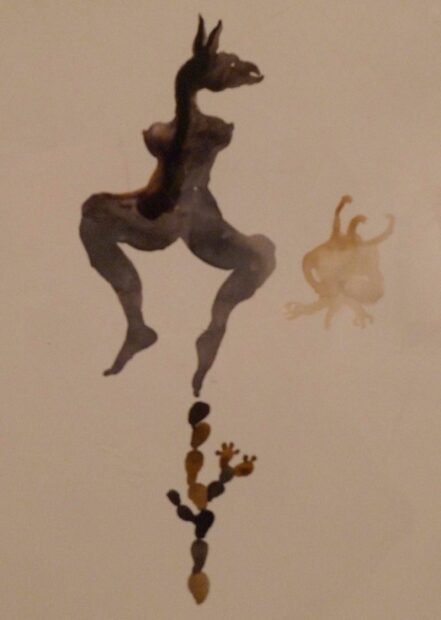
Shahzia Sikander, “The Pink Pavilion” (detail from a suite of watercolors), 2002, ink, opaque watercolor, and watercolor on clay-coated paper, collection of Jerry I. Speyer and Katherine G. Farley, New York. Photo: Ruben C. Cordova.
Sikander read a great deal of theory once she arrived in the U.S., and this knowledge is evident in her critical interrogations of received histories. She provided me with a statement that makes a good conclusion:
I’m questioning what is history. How I think of it is as an account of the movement of bodies, resources, objects, as in trade or slavery or migration. These patterns of movement – whether it’s migratory movements in current histories, or those from colonial occupations, or even earlier ones – these are all underlying currents, but they are also the root axis of modernity. Who gets to tell the story, how that story is told, is how history is defined (and how hierarchies of power get embedded in that storytelling).
***
Ruben C. Cordova is an art historian and curator. He has previously reviewed Calder-Picasso and Incomparable Impressionism and Ernesto Neto at the Museum of Fine Arts, Houston.



